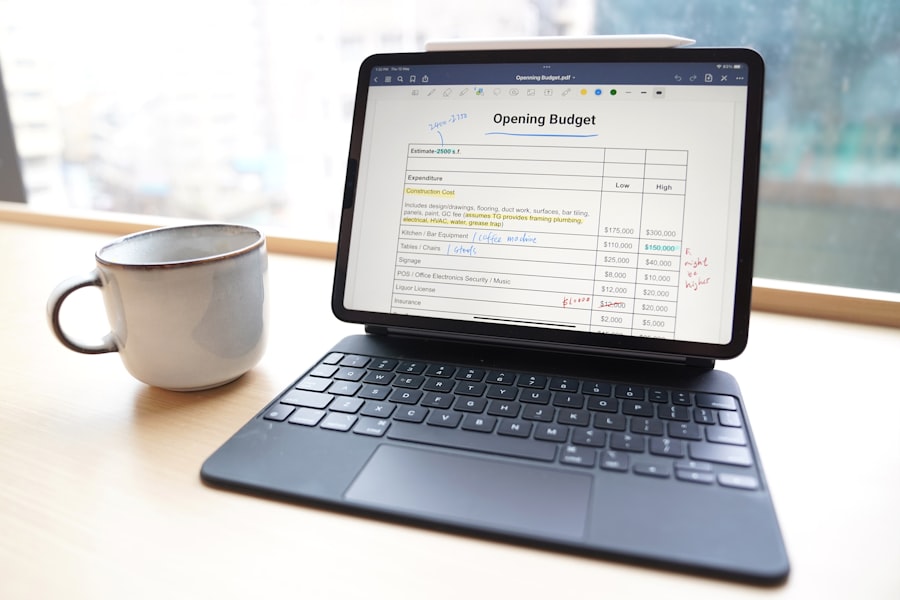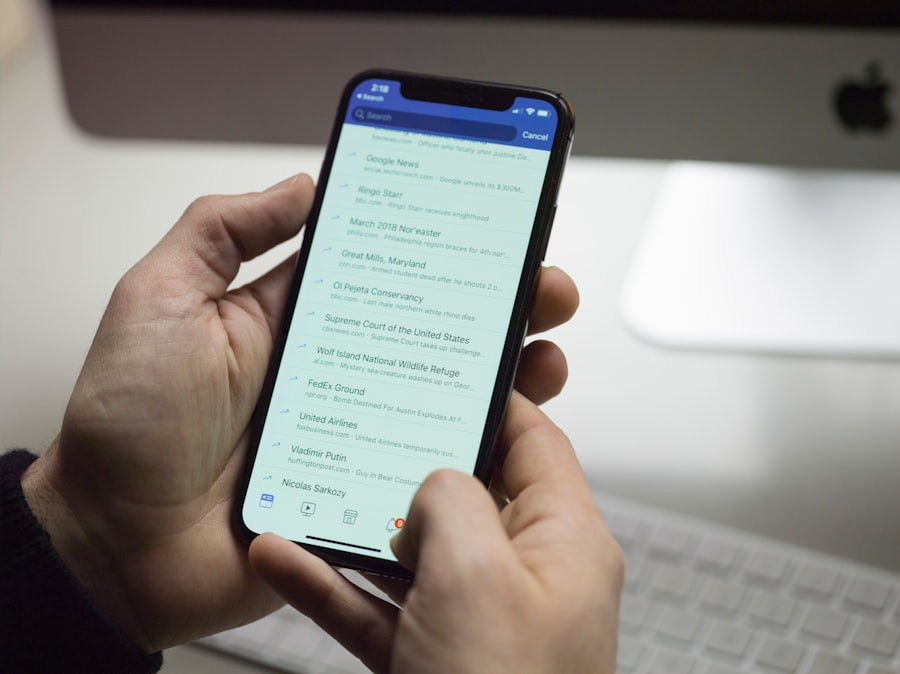In an era where financial literacy is paramount, the need for effective budgeting tools has never been more critical. Vala emerges as a frontrunner in this domain, specifically designed for iPhone users seeking to take control of their finances. This app is not just another budgeting tool; it is a comprehensive financial management system that empowers users to make informed decisions about their money.
With its user-friendly interface and robust features, Vala stands out as the best iPhone finance app for smart budgeting. The importance of budgeting cannot be overstated. It serves as the foundation for financial stability, allowing individuals to track their income, expenses, and savings goals.
Vala simplifies this process by providing a platform that integrates various financial aspects into one cohesive application. Whether you are a student managing limited funds or a professional looking to optimize your savings, Vala caters to diverse financial needs, making it an indispensable tool for anyone serious about personal finance.
Key Takeaways
- Vala is the best iPhone finance app for smart budgeting, offering a range of features to help users manage their personal finances effectively.
- The ultimate iPhone budget app, Vala comes with features such as expense tracking, budget goal setting, bill reminders, and customizable spending categories.
- Vala helps with personal finance management by providing users with a clear overview of their spending habits, helping them set and achieve financial goals, and offering insights into their financial health.
- Using Vala as an iPhone finance app comes with advantages such as easy expense tracking, real-time budget tracking, and the ability to sync across multiple devices.
- Tips for using Vala to achieve smart budgeting include setting realistic budget goals, tracking expenses diligently, and taking advantage of the app’s bill reminder feature.
- When compared to other iPhone finance apps, Vala stands out for its user-friendly interface, comprehensive features, and positive user reviews.
- User reviews and testimonials of Vala praise the app for its intuitive design, helpful features, and effectiveness in helping users achieve their financial goals.
- To download and get started with Vala on iOS, simply search for “Vala Budget App” in the App Store, download the app, and follow the on-screen instructions to set up an account and start using the app.
Features of Vala: The Ultimate iPhone Budget App
Vala is packed with features that set it apart from other budgeting apps on the market. One of its standout functionalities is the ability to create customizable budgets tailored to individual spending habits. Users can categorize their expenses into various segments such as groceries, entertainment, and utilities, allowing for a granular view of where their money is going.
This level of customization ensures that users can align their budgets with their unique financial situations and goals. Another remarkable feature of Vala is its real-time expense tracking. Users can input their transactions as they occur, which helps maintain an accurate picture of their financial status at any given moment.
This feature is particularly beneficial for those who struggle with keeping track of their spending throughout the month. Additionally, Vala offers visual representations of spending patterns through graphs and charts, making it easier for users to identify trends and adjust their budgets accordingly. The app also includes reminders for upcoming bills and due dates, ensuring that users never miss a payment and incur late fees.
How Vala Helps with Personal Finance Management

Vala goes beyond mere budgeting; it serves as a comprehensive personal finance management tool. One of the key ways it assists users is through goal setting. Users can establish specific financial goals, such as saving for a vacation or paying off debt, and Vala provides tailored strategies to help achieve these objectives.
The app breaks down larger goals into manageable steps, making the process less daunting and more achievable. Moreover, Vala incorporates educational resources that enhance users’ understanding of personal finance concepts. Through articles, tips, and tutorials, users can learn about effective saving strategies, investment basics, and debt management techniques.
This educational component not only empowers users to make better financial decisions but also fosters a sense of confidence in managing their finances. By combining practical tools with educational resources, Vala positions itself as a holistic solution for personal finance management.
The Advantages of Using Vala as an iPhone Finance App
One of the primary advantages of using Vala is its intuitive design, which makes navigation seamless even for those who may not be tech-savvy. The app’s layout is clean and organized, allowing users to access essential features without feeling overwhelmed.
This user-centric design philosophy ensures that individuals can focus on managing their finances rather than grappling with complicated software.
Additionally, Vala’s integration capabilities enhance its functionality. The app can sync with various bank accounts and credit cards, automatically importing transactions and categorizing them accordingly. This automation saves users time and reduces the likelihood of errors that can occur when manually entering data.
Furthermore, Vala employs robust security measures to protect sensitive financial information, giving users peace of mind as they manage their finances digitally.
Tips for Using Vala to Achieve Smart Budgeting
To maximize the benefits of using Vala for budgeting, users should start by setting clear financial goals. Whether it’s saving for a major purchase or building an emergency fund, having specific objectives in mind will guide budgeting decisions and motivate users to stick to their plans. Vala’s goal-setting feature can assist in breaking down these objectives into actionable steps.
Another effective strategy is to regularly review and adjust budgets based on changing circumstances. Life events such as job changes or unexpected expenses can impact financial situations significantly. By utilizing Vala’s real-time tracking and reporting features, users can identify areas where they may need to cut back or reallocate funds.
Regularly revisiting budgets ensures that they remain relevant and effective in achieving financial goals.
Comparison of Vala with Other iPhone Finance Apps

When comparing Vala with other iPhone finance apps, several distinguishing factors come into play. Many budgeting apps offer basic expense tracking and categorization; however, Vala excels in its comprehensive approach to personal finance management. While competitors may focus solely on budgeting, Vala integrates goal setting, educational resources, and real-time tracking into one cohesive platform.
For instance, apps like Mint provide robust expense tracking but may lack the depth of educational content that Vala offers. Similarly, while YNAB (You Need A Budget) emphasizes proactive budgeting techniques, it may not provide the same level of customization in goal setting as Vala does. This multifaceted approach makes Vala a more versatile option for users looking for a complete financial management solution rather than just a budgeting tool.
User Reviews and Testimonials of Vala: The Best iPhone Budget App
User feedback plays a crucial role in assessing the effectiveness of any app, and Vala has garnered positive reviews from its user base. Many users praise its intuitive interface and ease of use, highlighting how quickly they were able to set up their accounts and start tracking their finances. One user noted that “Vala has transformed the way I manage my money; I feel more in control than ever before.” Such testimonials reflect the app’s ability to resonate with individuals seeking a straightforward yet powerful budgeting solution.
Additionally, users have expressed appreciation for the educational resources available within the app. Many have commented on how the tips and articles have helped them develop better financial habits over time. A user shared that “the goal-setting feature has motivated me to save more effectively; I never thought I could reach my savings target so quickly.” These testimonials underscore Vala’s impact on users’ financial journeys and its role in fostering a community focused on smart budgeting.
How to Download and Get Started with Vala on iOS
Getting started with Vala is a straightforward process that begins with downloading the app from the Apple App Store. Users can search for “Vala” in the App Store or follow direct links provided on the official website or social media channels. Once downloaded, the app prompts users to create an account by entering basic information such as email address and password.
After account creation, users are guided through an onboarding process that familiarizes them with the app’s features and functionalities. This step-by-step introduction ensures that even those new to budgeting apps can navigate Vala with confidence. Users can then link their bank accounts or manually input transactions to begin tracking their finances immediately.
With its user-friendly setup process and comprehensive features, Vala makes it easy for anyone to embark on their journey toward smarter budgeting and improved financial health.
If you’re looking for a comprehensive budget tracking tool, you may want to check out Smartsheet.
This article on With the rise of smartphones and the internet, budgeting apps have transformed the way people approach their financial health.
They offer a user-friendly interface that simplifies complex financial concepts, making it easier for users to understand their spending habits and make informed decisions. The importance of budgeting cannot be overstated. It is a fundamental practice that allows individuals to allocate their resources wisely, avoid unnecessary debt, and work towards financial stability.
Budgeting apps have emerged as essential companions in this journey, providing features that cater to various financial needs. Whether you are a student managing limited funds, a professional saving for a home, or a retiree looking to stretch your savings, there is likely a budgeting app tailored to your specific situation. As we delve deeper into the world of budgeting apps, we will explore their features, benefits, and how they can be leveraged to achieve financial goals.
Key Takeaways
- Budgeting apps help individuals track and manage their finances on the go, making it easier to stay on top of their financial goals.
- When choosing a budgeting app, look for features such as customizable budget categories, bill tracking, goal setting, and syncing with bank accounts for accurate financial data.
- Some top budgeting apps for personal finance include Mint, YNAB (You Need a Budget), PocketGuard, and Goodbudget, each offering unique features to suit different financial needs.
- Pros of using budgeting apps include easy access to financial data, automated expense tracking, and the ability to set and monitor financial goals, while cons may include security concerns and potential reliance on technology.
- To use budgeting apps effectively, set clear financial goals, track spending regularly, and take advantage of the app’s features such as alerts and reports to stay on track with your budget.
- Budgeting apps can help individuals save money by providing insights into their spending habits, identifying areas for potential savings, and encouraging mindful spending through budget tracking and goal setting.
- Different budgeting apps cater to various financial goals, such as saving for a vacation, paying off debt, or building an emergency fund, so consider your specific financial objectives when choosing an app.
- In conclusion, choosing the right budgeting app depends on individual preferences, financial goals, and comfort level with technology, so take the time to research and test different apps to find the best fit for your needs.
Features to Look for in Budgeting Apps
Easy to Use and Understand
A user-friendly interface is crucial, allowing you to navigate the app effortlessly and input data with ease. A well-designed app should provide clear visualizations of your spending patterns, such as graphs and charts, giving you a quick overview of your financial situation.
Automated Tracking and Organization
The ability to sync with your bank accounts and credit cards is a key feature to look for. This functionality automates the tracking process by importing transactions directly from financial institutions, reducing the need for manual entry. Additionally, the app should allow you to categorize your expenses, either by creating custom categories or using predefined ones, to organize your spending effectively.
Staying on Top of Your Finances
Alerts and notifications can enhance your budgeting experience by reminding you of upcoming bills or alerting you when you’re nearing your budget limits. Some apps also offer goal-setting features, enabling you to set specific savings targets and track your progress over time.
Top Budgeting Apps for Personal Finance

Several budgeting apps have gained popularity due to their robust features and user satisfaction. One standout option is Mint, which offers comprehensive budgeting tools along with credit score monitoring. Mint allows users to connect multiple bank accounts and credit cards, automatically categorizing transactions and providing insights into spending habits.
Its goal-setting feature helps users save for specific objectives, such as vacations or emergency funds. Another noteworthy app is YNAB (You Need A Budget), which emphasizes proactive budgeting. YNAB encourages users to allocate every dollar they earn towards specific expenses or savings goals, promoting a zero-based budgeting approach.
This method helps users prioritize their spending and make informed financial decisions. YNAB also offers educational resources, including workshops and tutorials, making it an excellent choice for those new to budgeting. For individuals seeking a more minimalist approach, PocketGuard may be the ideal solution.
This app simplifies budgeting by showing users how much disposable income they have after accounting for bills, goals, and necessities. PocketGuard’s “In My Pocket” feature provides a clear picture of available funds, helping users avoid overspending while still enjoying their money.
Pros and Cons of Using Budgeting Apps
| Pros |
Cons |
| Easy tracking of expenses |
Potential security risks |
| Helps in setting and achieving financial goals |
May lead to over-reliance on technology |
| Provides insights into spending habits |
Some apps have limited features in free versions |
| Convenient access to financial information |
Requires time and effort to input data |
While budgeting apps offer numerous advantages, they are not without their drawbacks.
One significant benefit is the convenience they provide.
Users can access their financial information anytime and anywhere through their smartphones, allowing for real-time tracking of expenses and income.
This immediacy can lead to better financial decision-making as users can adjust their spending habits on the fly. Additionally, many budgeting apps offer valuable insights through data analysis. By examining spending patterns over time, users can identify areas where they may be overspending or where they can cut back.
This analytical approach can foster greater financial awareness and encourage healthier spending habits. On the flip side, one of the primary concerns with budgeting apps is data security. Users must provide sensitive financial information when linking bank accounts and credit cards, raising concerns about potential data breaches or unauthorized access.
It is essential for users to choose reputable apps with strong security measures in place. Another drawback is that some budgeting apps may require a subscription fee for premium features. While many apps offer free versions with basic functionalities, advanced tools often come at a cost.
Users should weigh the benefits of these premium features against their budgetary constraints before committing.
Tips for Using Budgeting Apps Effectively
To maximize the benefits of budgeting apps, users should adopt certain strategies that enhance their effectiveness. First and foremost, consistency is key. Regularly updating the app with new transactions ensures that users have an accurate picture of their financial situation.
Setting aside time each week or month to review expenses can help maintain accountability and encourage mindful spending. Another effective strategy is to customize categories based on personal spending habits. Many apps allow users to create tailored categories that reflect their unique lifestyle choices.
For instance, someone who frequently dines out may want a specific category for restaurant expenses. This level of customization enables users to gain deeper insights into their spending patterns and identify areas for improvement. Engaging with the educational resources offered by many budgeting apps can also enhance financial literacy.
Many platforms provide articles, videos, and workshops that cover various aspects of personal finance, from saving strategies to investment basics. By taking advantage of these resources, users can develop a more comprehensive understanding of money management.
How Budgeting Apps Can Help You Save Money

Budgeting apps are not just tools for tracking expenses; they can also play a pivotal role in helping individuals save money effectively. By providing a clear overview of income and expenditures, these apps enable users to identify unnecessary spending habits that may be draining their finances. For example, an individual may discover that they are spending significantly on subscription services they rarely use.
By eliminating or reducing these expenses, they can redirect those funds toward savings or debt repayment. Moreover, many budgeting apps incorporate goal-setting features that encourage users to save for specific objectives. Whether it’s building an emergency fund or saving for a vacation, these tools help users visualize their progress toward these goals.
The ability to set milestones and receive reminders can motivate individuals to stay committed to their savings plans. Additionally, some budgeting apps offer insights into potential savings opportunities by analyzing spending patterns and suggesting alternatives. For instance, if an app detects frequent dining out expenses, it might recommend meal planning or cooking at home as cost-effective alternatives.
This proactive approach not only helps users save money but also fosters healthier financial habits over time.
Budgeting Apps for Different Financial Goals
Different financial goals require tailored approaches, and budgeting apps can cater to various objectives effectively. For individuals focused on debt repayment, apps like Debt Payoff Planner can be invaluable. This app allows users to input their debts and create a personalized repayment plan based on their financial situation.
By visualizing progress toward debt reduction, users can stay motivated and committed to becoming debt-free. For those aiming to save for retirement or long-term investments, apps like Acorns or Betterment provide unique solutions. Acorns rounds up everyday purchases and invests the spare change into diversified portfolios, making it easier for individuals to start investing without feeling overwhelmed by large sums of money.
Betterment offers automated investment management tailored to individual risk tolerance and financial goals. Families planning for significant life events such as college tuition or home purchases may benefit from apps like Qapital or Simple. Qapital allows users to set up customizable savings rules—such as saving a specific amount every time they make a purchase—while Simple provides a holistic banking experience with built-in budgeting tools that help families manage their finances effectively.
Choosing the Right Budgeting App for You
Selecting the right budgeting app involves careful consideration of personal financial goals and preferences. With numerous options available in the market today, individuals should assess which features align best with their needs—be it expense tracking, goal setting, or investment management. It is also essential to consider factors such as user experience and security measures when making a choice.
Ultimately, the most effective budgeting app is one that resonates with your lifestyle and encourages you to take control of your finances actively. By leveraging technology in this way, individuals can cultivate better financial habits and work towards achieving their long-term financial aspirations with confidence and clarity.
If you are looking for the best budgeting apps to help you manage your finances, you should check out this article on Valapoint. It provides a comprehensive list of top budgeting apps that can assist you in tracking your expenses and saving money. Additionally, you may also want to explore the article on Valapoint to discover the best free budget tracker app recommended by Reddit users. These resources can help you find the perfect budgeting tool to suit your financial needs.
FAQs
What are budgeting apps?
Budgeting apps are software applications designed to help individuals and households manage their finances by tracking income, expenses, and savings goals. These apps often provide features such as expense categorization, bill reminders, and budget tracking to help users stay on top of their financial goals.
How do budgeting apps work?
Budgeting apps typically work by allowing users to input their income and expenses, which the app then uses to create a budget and track spending. Some apps also offer features such as linking to bank accounts to automatically track transactions, setting savings goals, and providing insights into spending habits.
What are the benefits of using budgeting apps?
Using budgeting apps can help individuals and households gain better control over their finances by providing a clear overview of income, expenses, and savings. These apps can also help users identify areas where they can cut back on spending, set and track savings goals, and avoid overspending.
Are budgeting apps secure?
Most budgeting apps take security seriously and use encryption and other security measures to protect users’ financial information. It’s important to choose a reputable app with a strong track record of security and to follow best practices such as using strong, unique passwords and enabling two-factor authentication when available.
What are some popular budgeting apps?
Some popular budgeting apps include Mint, YNAB (You Need a Budget), PocketGuard, Goodbudget, and EveryDollar. These apps offer a range of features and pricing options, so it’s important to research and choose the one that best fits your needs and preferences.





















